


xxxxxThe French painter Édouard Manet, was a disciple of the realist artist Gustave Courbet and a devoted admirer of the works of the old masters, especially Goya and Velasquez, but his insistence on painting everyday scenes from contemporary life cast him in the role of a revolutionary. Two works in particular, The Picnic on the Grass and Olympia, painted in 1863, shocked both the artistic establishment in Paris and the general public by their unseemly portrayal of nude women (one of them a prostitute) in an everyday setting. As a result, Manet found himself the rebel leader of a group of young artists seeking a new kind of realism - the so-called Impressionists. He himself was never in the mainstream of this movement, begun, as we shall see, by a work by Monet in 1872. However, working alongside Monet and others in the 1870s, he did produce, for example, Boating and the Seine at Argenteuil, works which came close to the hall-marks of Impressionism - the choice of mundane, outdoor subjects, free, broken brushwork, the blurring of contours, and emphasis on the transitory effects of light and colour. And his later painting, Bar at the Folies-Bergère, admirably captured the impression of a busy indoor scene, a snapshot glimpse before the eye focused on detail. Throughout his career he produced a vast number of spontaneous paintings of modern life. Many depicted the life of the social élite - the class to which he belonged - but he also painted café and street scenes, beggars and gypsies, formal portraits and current events. And he was also an accomplished printmaker and pastellist. Notable among his works were portraits of his friend Émile Zola, Concert in the Tuileries Gardens, The Balcony, The Railway, The Suicide, The Execution of Maximilian and The Barricade, a brutal scene taken during the Paris Commune of 1871. Apart from the Impressionists - particularly Monet, Degas, Renoir and Sisley - he numbered among his friends the French poet Charles Baudelaire, the American artist James Whistler, and the composer Jacques Offenbach. Recognition came late in life. Today he is seen as the precursor of modern painting.
ÉDOUARD MANET 1832 - 1883 (W4, Va, Vb, Vc)
Acknowledgements
Manet: The Café-Concert (of The Bock Drinkers) – Walters Art Museum, Baltimore, USA; Picnic on the Grass – Musée d’Orsay, Paris; Bar at the Folies Bergère – Courtauld Institute Galleries, London; In the Conservatory – Alte Nationalgalerie, Berlin; A Vase of Roses and Tulips – Buhrl Collection, Zurich; Autumn (a study of Méry Laurent) – Museum of Fine Arts, Nancy, France; Berthe Morisot – Musée d’Orsay, Paris. Degas: Self-Portrait – Musée d’Orsay, Paris; Woman Ironing – Musée d’Orsay, Paris; The Absinthe Drinker – Musée d’Orsay, Paris; Woman combing her hair – Hermitage Museum, St. Petersburg; Two Dancers on stage – Courtauld Institute Galleries, London; Little Dancer – Metropolitan Museum of Art, New York.
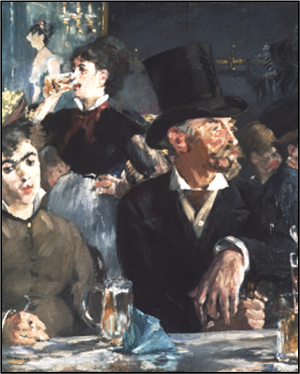 xxxxxThe French painter Édouard Manet, one of the most original artists of the 19th century, became a rebel in spite of himself. An elegant and cultured man of good breeding, he craved to be accepted by the French artistic establishment but, in fact, only gained public recognition towards the end of his life. A disciple of the French realist artist Gustave Courbet, and inspired as a student by the works of the old masters - particularly Goya and Velasquez - he was nevertheless determined to break away from the historical and mythological subjects of traditional art, and this made him an outcast. As such he found himself, willy-nilly, the leader of a group of dissident artists which included the so-called “Impressionists”, the first innovators in the development of modern art. He later worked with these painters, but he never exhibited with them, and he never saw himself as a strict member of their movement. (Illustrated here is one of his many Parisian café scenes.)
xxxxxThe French painter Édouard Manet, one of the most original artists of the 19th century, became a rebel in spite of himself. An elegant and cultured man of good breeding, he craved to be accepted by the French artistic establishment but, in fact, only gained public recognition towards the end of his life. A disciple of the French realist artist Gustave Courbet, and inspired as a student by the works of the old masters - particularly Goya and Velasquez - he was nevertheless determined to break away from the historical and mythological subjects of traditional art, and this made him an outcast. As such he found himself, willy-nilly, the leader of a group of dissident artists which included the so-called “Impressionists”, the first innovators in the development of modern art. He later worked with these painters, but he never exhibited with them, and he never saw himself as a strict member of their movement. (Illustrated here is one of his many Parisian café scenes.)
xxxxxManet was born in Paris, the eldest son of a highly-respected senior civil servant in the Ministry of Justice. As is often the case, his father wanted him to follow in his footsteps, but he made little progress at school, and by the age of 16 was determined to become an artist. To please his father he did spend a short time as an apprentice in the navy, serving on a transport ship to South America, but he failed the entrance examination on his return and that put an end to his naval career. In 1850, with his father’s consent, he went to Paris to study art. There he made a promising start, but whilst his style was certainly influenced by the Old Masters - particularly after visits to Germany, Italy and the Netherlands -, he showed little interest in their choice of subject, being anxious to paint a wide variety of scenes from contemporary life.
xxxxxWith this in mind, he produced The Absinthe Drinker in 1859, a back-street portrait of a drunken rag-and-bone man, but this was rejected out of hand by the French Salon. Nor did he fare any better three years later with his Concert in the Tuileries Gardens, a work depicting life at the other end of the social strata. A colourful, busy scene of the fashionable élite at leisure - and including portraits of celebrities such as the poet Charles Baudelaire, the writer Théophile Gautier, and the composer Jacques Offenbach - it too came in for some severe criticism. Studies of contemporary life, be it from the seamy or the privileged side of life, were not regarded as proper subject matter for the dedicated a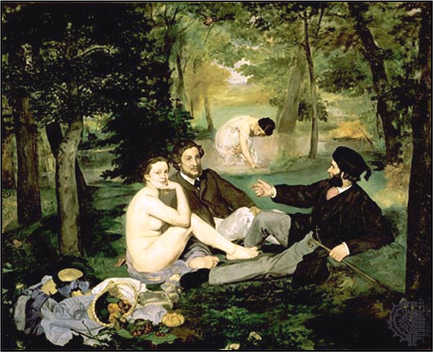 rtist.
rtist.
xxxxxWorse was to come. In 1863 his new painting Picnic on the Grass (Le Déjeuner sur l’Herbe) (illustrated), exhibited in the newly formed Salon des Refusés, provoked a furious outcry of scorn and disapproval, depicting as it did a contemporary outdoor scene in which a common, naked woman is pictured sitting alongside two fully clothed male companions. And this hostile reception was nothing compared with the furore that greeted his next major painting Olympia, exhibited at the Salon two years later and owing much in composition to Titian’s Venus of Urbino. The portrait of a prostitute, reclining provocatively on a couch and confronting the world with an impertinent, unashamed gaze of defiance, was seen as an affront to public good taste and attracted an unprecedented volume of abuse. “Insults,” he remarked at the time, “are pouring down on me as thick as hail stones”.
xxxxxFrom then on - not surprisingly - Manet was regarded as an arch rebel in the eyes of the artistic establishment. As a result, he soon became (whether he liked it or not), the admired leader and standard bearer of a growing band of non-conformist artists. His studio in the Batignolles Quarter, and the nearby Café Guerbois, provided the meeting places and the hot-beds for keen young painters seeking a new kind of realism. Among these were the Impressionists - such as Monet, Renoir and Sisley - a group of painters who were intrigued and influenced by Manet’s choice of subject, his fluent brushwork, and his treatment of light and shade. At this stage Manet was not an impressionist in the full sense of the word, but he later worked en plein air with Monet and others in the Paris suburb of Argenteuil, and at that period a number of his works, particularly his Boating and Seine at Argenteuil of 1874, showed many of the hall-marks of Impressionism - the choice of mundane, outdoor subjects, free, broken brush strokes, the blurring of contours, and the emphasis on the transitory effects of light and colo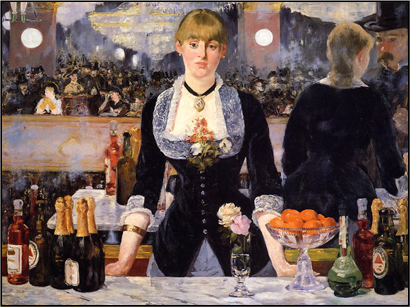 ur. And later, his famous Bar at the Folies-Bergère of 1882 (here illustrated), though a studio painting, was a notable impressionistic work in the way that it succeeded in capturing a busy scene as viewed at first glance, thus providing a realistic, spontaneous snapshot of a fleeting moment before the eye focused on any particular detail.
ur. And later, his famous Bar at the Folies-Bergère of 1882 (here illustrated), though a studio painting, was a notable impressionistic work in the way that it succeeded in capturing a busy scene as viewed at first glance, thus providing a realistic, spontaneous snapshot of a fleeting moment before the eye focused on any particular detail.
xxxxxAs we shall see, the Impressionists acquired their name from a work by Monet entitled Impression: Sunrise, produced in 1872, and the movement gave its first exhibition two years later.
xxxxxThroughout his career Manet painted pictures of modern life in a spontaneous style, freed from excessive detail. For the most part he captured the atmosphere of the day-to-day events of the glittering, fashionable society of which he was a member - such as masked balls and a day at the races - but he also produced paintings of beggars, gypsies and prostitutes, café and street scenes, landscapes, formal portraits and still lifes, and he excelled as a printmaker and a pastellist.
Including:
Stéphane Mallarmé
and Edgar Degas

xxxxxNotable among his enormous output were his portraits of his friends Émile Zola and Émile Bellot (Le Bon Bock), The Fifer of 1866, (clearly showing the influence of Velasquez), The Balcony of 1868, painted while on holiday in Boulogne, The Railway of 1873, and The Suicide of 1877, a grim image of death. And he also recorded current events. The Execution of Maximilian, based on photographs and eye-witness accounts, owed much to Goya’s famous painting of the 3rd of May, and The Barricade of 1871 depicted a brutal scene from the days of the Paris Commune. Among his religious works were Christ with Angels, painted in 1864, and The Mocking of Christ, produced the following year. Towards the end of his life, when he was struck down with a serious and painful illness - possibly caused by an advanced stage of syphilis - he turned to working in pastels and producing small flower paintings.
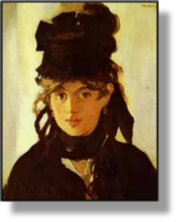 xxxxxApartxfrom his friendship with the Impressionists - particularly Claude Monet, Edgar Degas, Alfred Sisley and Pierre-Auguste Renoir - Manet was a close friend of the poet Charles Baudelaire, and knew the composer Jacques Offenbach and the American painter James Whistler. Andxhe was loyally supported throughout his career by Émile Zola - who saw him as “one of the masters of tomorrow” - and by a young, attractive and talented artist named Berthe Morisot (1841-1895) (portrait by Manet). She greatly admired his work and encouraged him to paint outdoors, thereby advancing his skill as an impressionist. Her own work was confined to the portrayal of family and domestic life. They met in 1868, and she married his brother Eugène in 1874. But the end of that decade saw the onset of Manet’s illness. He was crippled with pain for many years and died at the age of 51 following the amputation of his left foot. He never really achieved the recognition he sought from within the artistic establishment, but he was made a Chevalier of the Légion d’Honneur just two years before his untimely death. He has since come to be regarded as the father of modern painting, if not the founder of Impressionism, an artist who was more concerned with the colour, tone and texture of his painting than with the subject his art portrayed. He wanted, in his own words “ to produce not great art but sincere art”. In the event, he produced both.
xxxxxApartxfrom his friendship with the Impressionists - particularly Claude Monet, Edgar Degas, Alfred Sisley and Pierre-Auguste Renoir - Manet was a close friend of the poet Charles Baudelaire, and knew the composer Jacques Offenbach and the American painter James Whistler. Andxhe was loyally supported throughout his career by Émile Zola - who saw him as “one of the masters of tomorrow” - and by a young, attractive and talented artist named Berthe Morisot (1841-1895) (portrait by Manet). She greatly admired his work and encouraged him to paint outdoors, thereby advancing his skill as an impressionist. Her own work was confined to the portrayal of family and domestic life. They met in 1868, and she married his brother Eugène in 1874. But the end of that decade saw the onset of Manet’s illness. He was crippled with pain for many years and died at the age of 51 following the amputation of his left foot. He never really achieved the recognition he sought from within the artistic establishment, but he was made a Chevalier of the Légion d’Honneur just two years before his untimely death. He has since come to be regarded as the father of modern painting, if not the founder of Impressionism, an artist who was more concerned with the colour, tone and texture of his painting than with the subject his art portrayed. He wanted, in his own words “ to produce not great art but sincere art”. In the event, he produced both.
xxxxxIncidentally, in 1850 Manet started an affair with his piano teacher, a pretty Dutch girl named Suzanne Leenhoff. When, two years later, she gave birth to a boy - presumably by Manet - this was kept secret from his father. They married in 1863, following the death of his father, but even then Suzanne passed off the child, Leon, as her brother, and Manet professed to be the boy’s godfather!
……
xxxxx…… ThexSalon des Refusés was instituted by Napoleon III in 1863 after more than half the paintings submitted to the official Paris Salon were rejected - over 3,000 in number. A special exhibition, housed in an annex to the Salon, was held to give the general public an opportunity to judge the works for themselves. It was here that Manet’s Picnic on the Grass came in for such scornful criticism. Among the other works on display was James Whistler’s Girl in White. ……
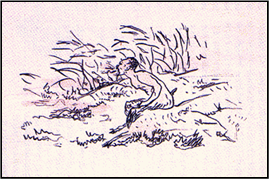 xxxxxInx1876 Manet produced the frontispiece (illustrated) for the poem L’Apres-midi d’un Faune, a wistful, sensuous dream by the French poet and critic Stéphane Mallarmé (1842-1898). In his early years Mallarmé was influenced by Baudelaire, but he later played a leading role in the development of the Symbolist Movement of 1886, along with his countryman Paul Verlaine. As a symbolist poet, Mallarmé aimed at describing “not the thing, but the effect which it produces”. As a result some of his work, seen as a means of reaching a higher reality in the pursuit of the perfect form, was little understood in his time, but it anticipated the schools of Surrealism and Futurism which were to emerge in the opening years of the 20th century.
xxxxxInx1876 Manet produced the frontispiece (illustrated) for the poem L’Apres-midi d’un Faune, a wistful, sensuous dream by the French poet and critic Stéphane Mallarmé (1842-1898). In his early years Mallarmé was influenced by Baudelaire, but he later played a leading role in the development of the Symbolist Movement of 1886, along with his countryman Paul Verlaine. As a symbolist poet, Mallarmé aimed at describing “not the thing, but the effect which it produces”. As a result some of his work, seen as a means of reaching a higher reality in the pursuit of the perfect form, was little understood in his time, but it anticipated the schools of Surrealism and Futurism which were to emerge in the opening years of the 20th century.
xxxxxMallarmé made his living as an English teacher - having spent some time in England after leaving school - but his little apartment in the Rue de Rome, Paris, became famous as the meeting place for the intellectuals of the day. Knownxas Mardists because they met on a Tuesday, they included the painters Monet, Degas, Renoir and Whistler, the sculptor Rodin, the Irish writer and poet Oscar Wilde, and Claude Debussy, the French composer who orchestrated L’Apres-midi d’un Faune in 1894. Among Mallarmé’s other works were the verse drama Hérodiade of 1869, and his most ambitious as well as his most complex work, A roll of the dice will never abolish chance, completed in the year before his death. And in 1875 he translated into French The Raven, the narrative poem by the American writer and poet Edgar Allan Poe.
xxxxxThe French painter Edgar Degas (1834-1917) studied classical art early on in his career, but after meeting Édouard Manet in the early 1860s he turned to painting contemporary scenes and portraiture. Like Manet, he joined the Impressionists as a protest against the outmoded views of the Salon, and from 1874 to 1886 he exhibited in all but one of their eight exhibitions. He had much in common with the Impressionists. He used bold colours, chose workaday subjects, and aimed to capture spontaneous images. This he achieved in commonplace incidents such as women doing household chores or at their toilette, ballet dancers in training, or the bustling life of Paris by night. But he remained a classical artist at heart. His works, in fact, were painstakingly planned, he had no time for landscape painting, and he showed no interest in the effects of light, a hallmark of the Impressionists. Furthermore, many of his works were aimed at catching movement, be it in ballet dancing or horse racing, and in some instances he chose off-centre viewpoints to portray his subjects. He was a prolific artist and he experimented with a variety of media, including oil, watercolour and pastel. With the failure of his eyesight in his later years he turned more and more to pastels, and he also achieved some success as a sculptor. The naturalness of his portraiture and figure painting, and his remarkable talent for depicting the feeling of movement - particularly evident in his depiction of ballet dancers - make him one of the outstanding exponents of modern art in the late 19th century.
xxxxxThe French artist Edgar Degas (1834-1917) met Édouard Manet in the early 1860s while copying paintings in the Louvre. Earlier he worked in Italy, producing work based on the early Renaissance masters but, after meeting Manet he turned his attention to portraiture and scenes of contemporary life, using a variety of media. And, like Manet, he was drawn into the Impressionist Movement as a protest against the set ways of the artistic hierarchy rather than by any overwhelming belief in their tenets. Thus whilst he clearly showed an appreciation of the movement’s aims and followed some way in the footsteps of its members, he always remained true to the classical tradition, and his contribution to modern art was unique in a number of ways.
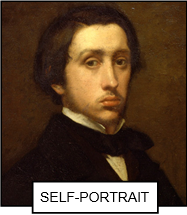 xxxxxDegas was born into a wealthy Parisian family, the eldest of five children. To meet the wishes of his father, a city banker, he began studying law in 1853. He had no interest in the subject, however, and two years later, after a meeting with the celebrated neoclassical painter Jean Auguste Ingres, then aged 75 - a man whom he greatly admired - he decided to become an artist. He studied at the École des Beaux Arts and quickly showed his outstanding talent as a draughtsman. On completion of his training he worked for three years in Italy, where his work was based on Renaissance masters such as Michelangelo, Raphael and Titian.
xxxxxDegas was born into a wealthy Parisian family, the eldest of five children. To meet the wishes of his father, a city banker, he began studying law in 1853. He had no interest in the subject, however, and two years later, after a meeting with the celebrated neoclassical painter Jean Auguste Ingres, then aged 75 - a man whom he greatly admired - he decided to become an artist. He studied at the École des Beaux Arts and quickly showed his outstanding talent as a draughtsman. On completion of his training he worked for three years in Italy, where his work was based on Renaissance masters such as Michelangelo, Raphael and Titian.
xxxxxOn returning to Paris and meeting Manet he gave up “history”, as he put it, and in the late 1860s turned to scenes of contemporary life and portraiture. His candid capture of commonplace incidents - be it women doing household chores, women at their toilette, ballet dancers in training, or the colourful, bustling life of Paris by night - was truly remarkable, and, by possessing a complete air of naturalness, belied the fact that they were meticulously composed with classical precision. In 1872, following the Franco-Prussian War (during which he took part in the defence of Paris) he spent some months in New Orleans, where his brother René lived. It was here that he produced his first major work, The Corn Exchange, a painting noted for its balance and close detail.
xxxxxOn returning to Paris, however, he rebelled against the rigid restrictions and judgments imposed by the Salon and, like Manet before him, joined the “Impressionists”, a group of young artists who sought a new departure in subject matter and style. He exhibited in all but one of their eight exhibitions, held from 1874 to 1886, and mixed with the likes of Monet, Renoir and Sisley, all of whom he had met at the Café Guerbois in the 1860s. Not surprisingly, in the eyes of the public he was seen as an Impressionist and in certain aspects that was perfectly understandable. He used strong colours, laid on with bold brush strokes, chose workaday subjects as seen through the keyhole, as it were, and aimed to capture a fleeting, often moving image of his subject, as though it were frozen in time like a photographic snapshot.
xxxxxHowever, at heart, as in the case of Manet, he remained true to his classical training. Unlike the Impressionists he showed little interest in landscape painting, was bluntly opposed to working out of doors, and made no effort to convey the transitory effects of changing light, realised in part by ”colour-flecking” and blurred outlines. Furthermore, there was nothing spontaneous about his work. Though one might not think it, every study was meticulously planned. And in addition he produced a number of inventive, unique compositions wherein the unconventional, off-centre view point was of more importance than the subject matter itself - as seen in his Woman with Chrysanthemums of 1865.
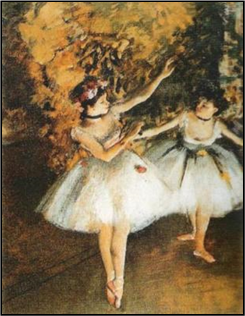
xxxxxDegas was a prolific artist and he experimented with a variety of media, including oil, watercolour, pastel, aquatint and etching. By the 1870s he had become a master in oil, but it was in pastel that he best achieved his unique patterning of colour, another product of his classical training. He was primarily a figure painter, and he showed a remarkable talent for depicting the feeling of movement, clearly visible in his depiction of ballet dancers and horses. In these and all his common-place studies, he showed a keen observation of humanity, and a rare ability to capture immediacy, the action or gesture of the moment, whether his subject be a washerwoman, a day at the races, or a scene from café life. Even in his nude studies - his “femme au tub”- there was little beauty of form, and some of his models were downright ugly. He painted what he saw.
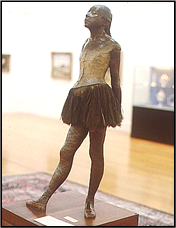 xxxxxDegas was one of the outstanding exponents of modern art in the late 19th century - whatever label is attached to him. Today he is remembered above all for his brilliant paintings of ballet dancers, many viewed from the stage wings, in the rehearsal room, or with live models in his studio. And his portraits, capturing as they did the very essence of the sitter, now rank among the finest in the history of art. By the late 1870s, however, his eyesight began to fail, and he was almost blind by the time of his death. For this reason in his later years he concentrated more on pastels - thereby avoiding precise lines - and he turned increasingly to sculpture, modelling figures and horses in wax. His most famous work in this respect is his The Little Dancer of 1881, to be seen in the Tate Gallery, London, and illustrated here. He was working in pastels and producing sculptures well into the 20th century, and it was during this period that he turned his hand to photography.
xxxxxDegas was one of the outstanding exponents of modern art in the late 19th century - whatever label is attached to him. Today he is remembered above all for his brilliant paintings of ballet dancers, many viewed from the stage wings, in the rehearsal room, or with live models in his studio. And his portraits, capturing as they did the very essence of the sitter, now rank among the finest in the history of art. By the late 1870s, however, his eyesight began to fail, and he was almost blind by the time of his death. For this reason in his later years he concentrated more on pastels - thereby avoiding precise lines - and he turned increasingly to sculpture, modelling figures and horses in wax. His most famous work in this respect is his The Little Dancer of 1881, to be seen in the Tate Gallery, London, and illustrated here. He was working in pastels and producing sculptures well into the 20th century, and it was during this period that he turned his hand to photography.
xxxxxDegas was not an easy man to get along with. He often appeared haughty and aloof but, as his work shows, he possessed a wealth of sensibility. He outlived most of his closest friends and ended his days a lonely, sad figure. Thexart world didn’t quite know how to take him. Some dismissed him out of hand, whilst others, like Henri de Toulouse-Lautrec, admired his work. He had no direct following in France, but one of his pupils, the German-born English artist Walter Sickert (1860-1942) championed a version of impressionism in England in the early 1900s.
xxxxxIncidentally, Degas was strongly anti-Semitic, a fact that came out during the famous Dreyfus Affair of 1894. Indeed, such was the strength of his feeling that he broke off relations with all his Jewish friends, including his long-term art colleagues Renoir and Cézanne. ……
xxxxx…… On one occasion Degas painted his close friend Édouard Manet while he was listening to his wife playing the piano. Manet was so displeased with the portrait of his wife that he cut the canvas in order to take her out of the picture! ……
xxxxx…… During his long career Degas built up a large art collection. This included paintings by Manet, Pissarro, Cézanne, Gauguin and Van Gogh, as well as works by El Greco and the two artists he most admired, Delacroix and Ingres. In addition he amassed a large number of drawings and Japanese prints.
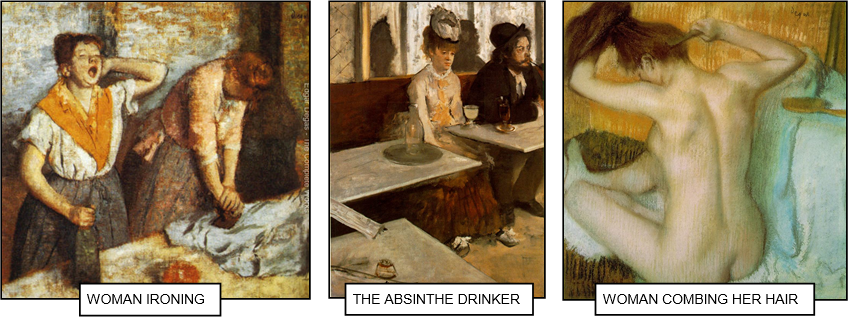
Vb-1862-1880-Vb-1862-1880-Vb-1862-1880-Vb-1862-1880-Vb-1862-1880-Vb-1862-1880-Vb
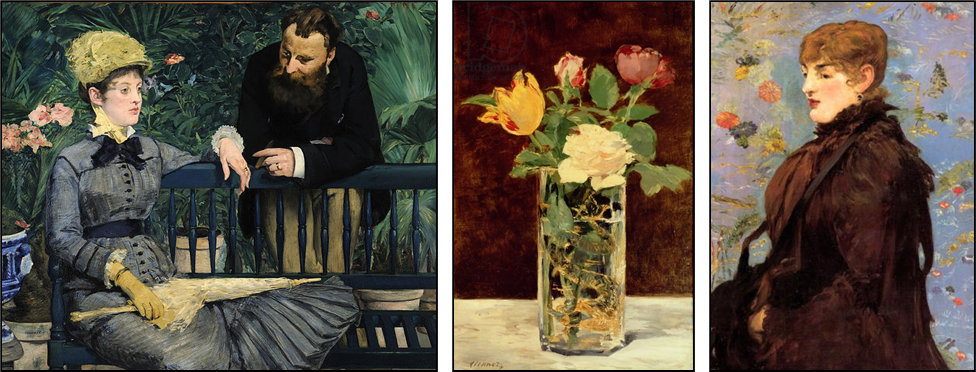






 xxxxxThe French painter Édouard Manet, one of the most original artists of the 19th century, became a rebel in spite of himself. An elegant and cultured man of good breeding, he craved to be accepted by the French artistic establishment but, in fact, only gained public recognition towards the end of his life. A disciple of the French realist artist Gustave Courbet, and inspired as a student by the works of the old masters -
xxxxxThe French painter Édouard Manet, one of the most original artists of the 19th century, became a rebel in spite of himself. An elegant and cultured man of good breeding, he craved to be accepted by the French artistic establishment but, in fact, only gained public recognition towards the end of his life. A disciple of the French realist artist Gustave Courbet, and inspired as a student by the works of the old masters - rtist.
rtist. ur. And later, his famous Bar at the Folies-
ur. And later, his famous Bar at the Folies-
 xxxxxApartxfrom his friendship with the Impressionists -
xxxxxApartxfrom his friendship with the Impressionists - xxxxxInx1876 Manet produced the frontispiece (illustrated) for the poem L’Apres-
xxxxxInx1876 Manet produced the frontispiece (illustrated) for the poem L’Apres- xxxxxDegas was born into a wealthy Parisian family, the eldest of five children. To meet the wishes of his father, a city banker, he began studying law in 1853. He had no interest in the subject, however, and two years later, after a meeting with the celebrated neoclassical painter Jean Auguste Ingres, then aged 75 -
xxxxxDegas was born into a wealthy Parisian family, the eldest of five children. To meet the wishes of his father, a city banker, he began studying law in 1853. He had no interest in the subject, however, and two years later, after a meeting with the celebrated neoclassical painter Jean Auguste Ingres, then aged 75 -
 xxxxxDegas was one of the outstanding exponents of modern art in the late 19th century -
xxxxxDegas was one of the outstanding exponents of modern art in the late 19th century -



